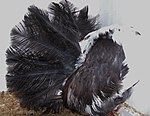No, not Tumblrs! One of the most popular and prized show birds in the
Victorian era was a “performance bird”—the Almond Tumbler. Like other
Tumblers, the birds were originally bred because of their curious flight
patterns. After flying very high up, they do a series of very fast,
very impressive back flips, before flying straight up again. Of course,
this bizarre flight would make them prime prey for hawks and falcons,
but for their breeders, the most brilliant feathers and fastest spins
are exactly what’s wanted for the next generation. One family of this
breed, the Short-Faced Tumblers (of which the Almond Tumbler is a
member), is loved for its very “dainty” look, but this look is at the
expense of beak length; the tiny beaks of the family (and the
Short-Faced types in other breeds and families) mean that they can no
longer effectively feed their young, and the squabs must be hand-raised.
Despite some of the Fancies looking like a taxidermied light bulb, or a tiny peacock with a snake for a neck, the bizarre traits are only skin-deep. In writing The Origin of Species, Charles Darwin cross-bred many different pigeon breeds, and showed that within one or two generations, the majority of offspring would resemble “wild-type” Rock Doves—the iridescent head, bluish tint, and barred wings. But the genes of domesticity still exist in our feral pigeons today: The speckled white, piebald, unusually-shaped, and unusually-sized pigeons of our cities are the result of parents carrying the gene mutations humans exploited generations ago. In the natural habitat of the Rock Dove, these odd colors and shapes would surely be a disadvantage and would be swiftly eliminated by natural predators. But on the brownstone and concrete cliffs of humans, the oddities manage to survive and thrive, and pass their genes on to the next generation.
Tumbler pigeons are varieties of domesticated pigeons descendant from the rock dove that have been selected for their ability to tumble or roll over backwards in flight.
This ability has been known in domesticated breeds of pigeons for centuries. In Wendell Levi's book The Pigeon, reference is made to pigeons with this tumbling ability existing in India before the year 1590. Charles Darwin, in his book The Origin of Species, makes reference to the Short Faced Tumbler which was a popular breed during his lifetime, and still can be found exhibited at pigeon shows today.
There are many different breeds that have descended from the original tumbler stocks. Some of the more popular breeds today include:
Despite some of the Fancies looking like a taxidermied light bulb, or a tiny peacock with a snake for a neck, the bizarre traits are only skin-deep. In writing The Origin of Species, Charles Darwin cross-bred many different pigeon breeds, and showed that within one or two generations, the majority of offspring would resemble “wild-type” Rock Doves—the iridescent head, bluish tint, and barred wings. But the genes of domesticity still exist in our feral pigeons today: The speckled white, piebald, unusually-shaped, and unusually-sized pigeons of our cities are the result of parents carrying the gene mutations humans exploited generations ago. In the natural habitat of the Rock Dove, these odd colors and shapes would surely be a disadvantage and would be swiftly eliminated by natural predators. But on the brownstone and concrete cliffs of humans, the oddities manage to survive and thrive, and pass their genes on to the next generation.
Tumbler pigeons are varieties of domesticated pigeons descendant from the rock dove that have been selected for their ability to tumble or roll over backwards in flight.
This ability has been known in domesticated breeds of pigeons for centuries. In Wendell Levi's book The Pigeon, reference is made to pigeons with this tumbling ability existing in India before the year 1590. Charles Darwin, in his book The Origin of Species, makes reference to the Short Faced Tumbler which was a popular breed during his lifetime, and still can be found exhibited at pigeon shows today.
There are many different breeds that have descended from the original tumbler stocks. Some of the more popular breeds today include:

















































